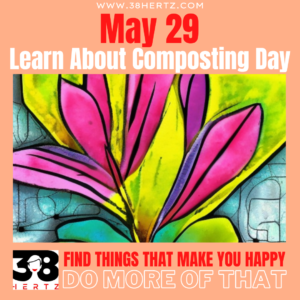
Learn how to compost on Learn About Composting Day!
Composting may not be something that immediately comes to mind when you think of ways to make a difference for the environment, or a thing to celebrate, but it is a practice with significant benefits. Essentially, composting involves taking your food scraps and yard waste and breaking them down into nutrient-rich soil that can be used to nourish plants and gardens. Not only does this reduce the amount of waste that ends up in landfills, but it also reduces greenhouse gas emissions that are generated by decomposing organic matter.
Additionally, learning how to compost can help to reduce erosion and water usage, improve soil quality, and even promote healthy plant growth. By learning more about the value of composting, you can make an impactful and eco-friendly choice for your own household. Celebrate today by learning how to compost!
HOW TO COMPOST: THE HISTORY OF COMPOSTING
Composting, a natural process of decomposition, has roots stretching back thousands of years. Ancient civilizations, such as the Greeks and Romans, recognized the value of organic waste as a soil amendment. They utilized compost to improve soil fertility and agricultural yields. In Asia, the practice of composting dates back to ancient China, where farmers utilized crop residues and organic waste to replenish soil nutrients. Similarly, traditional agricultural practices in India incorporated composting techniques known as “waste to wealth.”
During the Middle Ages in Europe, composting continued to be an essential practice for soil enrichment. The importance of composting was further emphasized during the Agricultural Revolution in the 18th century when scientists such as Sir Albert Howard and Lady Eve Balfour highlighted its benefits for sustainable agriculture. how to compost
In the 20th century, composting gained renewed attention with the emergence of organic farming movements and environmental awareness. Governments and organizations worldwide began promoting composting as a means of waste reduction and soil conservation. Today, composting is recognized as a vital component of sustainable waste management and soil health practices, with diverse applications in agriculture, landscaping, and urban gardening. Its rich history reflects humanity’s enduring relationship with the land and the wisdom of harnessing natural processes to cultivate a healthier planet. how to compost
100 TIPS ON HOW TO COMPOST SUCCESSFULLY
- Choose the Right Location: Select a suitable spot for your compost bin or pile, ideally in a shaded area.
- Layer Greens and Browns: Alternate layers of green (nitrogen-rich) and brown (carbon-rich) materials for optimal decomposition.
- Shred or Chop Materials: Break down larger materials into smaller pieces to accelerate decomposition.
- Balance Moisture Levels: Keep the compost moist like a wrung-out sponge, but not overly wet.
- Turn the Pile Regularly: Aerating the compost pile by turning it helps speed up the decomposition process.
- Cover the Pile: Use a lid or tarp to cover the compost pile to retain moisture and heat.
- Add Airflow: Incorporate bulky materials like twigs or cardboard tubes to create airflow within the pile.
- Use Compost Accelerators: Consider adding compost activators or accelerators to speed up decomposition.
- Include Microorganisms: Introduce compost starter kits or finished compost to inoculate your pile with beneficial microbes.
- Monitor Temperature: Check the temperature of the compost pile regularly—it should be warm but not hot.
- Keep Out Weeds and Seeds: Avoid adding weeds or plants that have gone to seed to prevent them from sprouting in your compost.
- Avoid Meat and Dairy: Exclude meat, dairy, and oily foods from your compost to prevent odors and pests.
- Use a Variety of Materials: Include a diverse range of materials in your compost pile for balanced nutrients.
- Crush Eggshells: Crush eggshells before adding them to your compost to speed up decomposition.
- Water Strategically: Water your compost pile during dry spells or if it becomes too dry.
- Avoid Glossy Paper: Exclude glossy or heavily inked paper from your compost as it may contain harmful chemicals.
- Cover Food Scraps: Cover kitchen scraps with a layer of browns to deter pests and minimize odors.
- Keep it Aerated: Use a compost aerator or pitchfork to aerate the pile and prevent it from becoming compacted.
- Add Worms: Introduce composting worms like red wigglers to help break down organic matter.
- Monitor pH Levels: Check the pH of your compost occasionally and adjust if it becomes too acidic or alkaline.
- Use Grass Clippings Wisely: Use grass clippings sparingly in your compost to avoid clumping and odor issues.
- Layer Small and Large Materials: Alternate layers of small and large materials to improve airflow and decomposition.
- Avoid Pet Waste: Exclude pet waste from your compost to prevent the spread of pathogens and parasites.
- Compost Tea: Make compost tea by steeping finished compost in water for a nutrient-rich liquid fertilizer.
- Use Natural Pest Control: Employ natural pest control methods like diatomaceous earth to manage pests in your compost.
- Cover with Mulch: Covering the compost pile with mulch helps regulate temperature and moisture levels.
- Avoid Chemicals: Avoid adding materials treated with chemicals or pesticides to your compost.
- Use a Compost Thermometer: Monitor the temperature of your compost pile with a compost thermometer to gauge its activity.
- Keep it Small: Start with a small compost pile or bin if you’re new to composting to manage it more easily.
- Add Wood Ash: Incorporate small amounts of wood ash into your compost to balance pH levels.
- Layer in Newspaper: Use shredded newspaper as a carbon source in your compost pile.
- Rotate Bin Locations: Rotate the location of your compost bin periodically to distribute nutrients evenly in the soil.
- Crush Leaves: Crush or shred leaves before adding them to your compost to speed up decomposition.
- Use a Tumbler: Consider using a compost tumbler for easy turning and faster decomposition.
- Avoid Diseased Plants: Exclude diseased plants from your compost to prevent the spread of pathogens.
- Use Coffee Grounds: Add coffee grounds to your compost for nitrogen and organic matter.
- Maintain Moisture: Avoid letting the compost pile dry out completely, as this slows down decomposition.
- Cover with Burlap: Covering the compost pile with burlap allows airflow while retaining moisture.
- Include Cardboard: Tear up cardboard and add it to your compost as a source of carbon.
- Use Urine Sparingly: Urine can be added to compost as a nitrogen source, but use it sparingly to avoid imbalance.
- Avoid Synthetic Materials: Exclude synthetic materials like plastics or fabrics from your compost.
- Chop Cornstalks: Chop up cornstalks before adding them to your compost to facilitate decomposition.
- Include Manure: Use aged manure from herbivores as a nitrogen-rich additive to your compost.
- Use Kitchen Scraps Wisely: Chop kitchen scraps into smaller pieces to accelerate decomposition.
- Avoid Fats and Oils: Exclude fats, oils, and greasy foods from your compost to prevent odor and pest issues.
- Cover Kitchen Scraps: Cover kitchen scraps with a layer of browns immediately after adding them to the compost.
- Layer with Seaweed: Use seaweed as a nitrogen-rich addition to your compost pile.
- Mix Ingredients Thoroughly: Mix the compost pile thoroughly when adding new materials to ensure even decomposition.
- Avoid Charcoal Ash: Exclude ash from charcoal or coal from your compost due to potential contaminants.
- Use Cover Crops: Plant cover crops in your compost pile during the off-season to add organic matter.
- Compost Fallen Fruit: Add fallen fruit from trees to your compost pile, but avoid large quantities to prevent imbalance.
- Keep Compost Moist, Not Wet: Ensure the compost pile is consistently moist, but not soggy, to aid decomposition.
- Avoid Glossy Magazines: Exclude glossy magazines from your compost due to the presence of harmful chemicals in the ink.
- Use a Compost Sieve: Screen finished compost through a sieve to remove large chunks and hasten maturation.
- Avoid Synthetic Fibers: Exclude synthetic fibers like polyester or nylon from your compost pile.
- Use a Compost Cover: Covering the compost pile with a breathable cover helps retain moisture and heat.
- Compost Fireplace Ash: Add fireplace ash to your compost in moderation as a source of potassium.
- Avoid Meat and Bones: Exclude meat, bones, and fatty foods from your compost to prevent pests and odors.
- Keep Compost Bin Closed: Keep the compost bin closed to deter pests and rodents from accessing the pile.
- Use Hay or Straw: Use hay or straw as a carbon-rich component in your compost pile.
- Avoid Dairy Products: Exclude dairy products from your compost to prevent odor issues and attract pests.
- Compost Pet Fur: Add pet fur or hair to your compost pile as a source of nitrogen.
- Keep Compost Aeration Holes Open: Ensure aeration holes in compost bins or piles are not blocked to maintain airflow.
- Use Compost Coverings: Covering compost materials with a layer of finished compost helps prevent odors and pests.
- Avoid Diseased Leaves: Exclude leaves with signs of disease from your compost to prevent spreading pathogens.
- Use Rainwater: Collect rainwater for watering your compost pile to avoid introducing chemicals from tap water.
- Compost Seaweed: Rinse saltwater off seaweed before adding it to your compost to avoid excess sodium.
- Avoid Weeds with Seeds: Exclude weeds with seeds from your compost to prevent them from germinating in your garden.
- Compost Wood Chips: Add wood chips to your compost pile in moderation as a carbon source.
- Keep Compost Bin Elevated: Elevate compost bins to prevent access by pests like rodents and raccoons.
- Use Egg Cartons: Tear up cardboard egg cartons and add them to your compost as a source of carbon.
- Avoid Chemically Treated Wood: Exclude chemically treated wood or sawdust from your compost due to potential toxins.
- Compost Pine Needles: Add pine needles to your compost in moderation as a source of acidity.
- Use Lawn Clippings: Add grass clippings to your compost pile as a nitrogen-rich component.
- Avoid Glossy Labels: Remove glossy labels from fruit and vegetable scraps before adding them to your compost.
- Compost Tea Bags: Tear open used tea bags and add the contents to your compost pile, excluding any staples or strings.
- Use Plant-Based Materials: Use plant-based materials like paper bags and cardboard for composting instead of synthetic alternatives.
- Compost Dry Leaves: Use dry leaves as a carbon source in your compost pile, shredding them for faster decomposition.
- Avoid Coal Ash: Exclude ash from coal or charcoal from your compost due to potential toxins and contaminants.
- Compost Citrus Peels: Add citrus peels to your compost pile in moderation as a source of acidity and nutrients.
- Use a Tarp as Cover: Cover your compost pile with a tarp during heavy rain to prevent it from becoming waterlogged.
- Compost Newspaper: Tear up newspaper and add it to your compost as a carbon-rich material, avoiding colored or glossy pages.
- Use Banana Peels: Add banana peels to your compost pile for a boost of potassium and other nutrients.
- Compost Straw: Use straw as a carbon source in your compost pile, breaking it up for faster decomposition.
- Use Pineapple Tops: Plant pineapple tops in your compost pile to propagate new plants while adding organic matter.
- Compost Nut Shells: Crush nut shells and add them to your compost for slow-release nutrients.
- Use a Compost Bin Liner: Line your compost bin with newspaper or cardboard to absorb excess moisture and prevent sticking.
- Compost Seaweed Wrappers: Rinse seaweed wrappers and add them to your compost as a source of carbon.
- Use a Compost Sifter: Sift finished compost through a mesh screen to remove large chunks and debris.
- Compost Pumpkin Guts: Add pumpkin guts to your compost pile for a boost of nitrogen and organic matter.
- Use Paper Towel Rolls: Tear up cardboard paper towel rolls and add them to your compost as a source of carbon.
- Compost Avocado Pits: Crush avocado pits and add them to your compost for slow-release potassium.
- Use Sawdust Sparingly: Add sawdust to your compost in moderation as a carbon source, avoiding treated or stained wood.
- Compost Bread Crusts: Add bread crusts to your compost for a source of carbon and organic matter.
- Use Dryer Lint: Add dryer lint to your compost as a source of carbon, avoiding synthetic fibers.
- Compost Corn Cobs: Chop up corn cobs and add them to your compost for slow-release nutrients.
- Use Stale Cereal: Crush stale cereal and add it to your compost as a source of carbon and organic matter.
- Compost Pasta Scraps: Add pasta scraps to your compost for a source of carbon and organic matter.
- Use Stale Chips: Crush stale chips and add them to your compost as a source of carbon.
- Compost Old Spices: Add old spices to your compost for a source of carbon and to deter pests.
HOW TO CELEBRATE LEARN ABOUT COMPOSTING DAY and HOW TO COMPOST
Learn how to compost effectively with these simple tips. From choosing the right location to balancing moisture levels and adding the right materials, discover the key steps to successful composting. Whether you’re a beginner or looking to refine your composting process, this guide provides practical advice for turning kitchen scraps and yard waste into nutrient-rich soil amendment. Start composting today and contribute to a healthier environment while enriching your garden or landscape. Celebrate the day and learn how to compost!
- Purchase composting supplies.
- Take a course in composting.
- Learn how to compost indoors.
- Things to do with compost if you don’t garden.
- If you love the article image, purchase it on these fun products on Zazzle!
- Download the 38 Hertz Celebration Book for 265 days of celebrations!
FEATURED ITEM FOR LEARNING ABOUT COMPOSTING DAY
Note: If the above links do not direct you to the appropriate referral on the first try, return to the article and try again.
Do you have any ideas about how to compost on Learn About Composting Day? Please share them!













